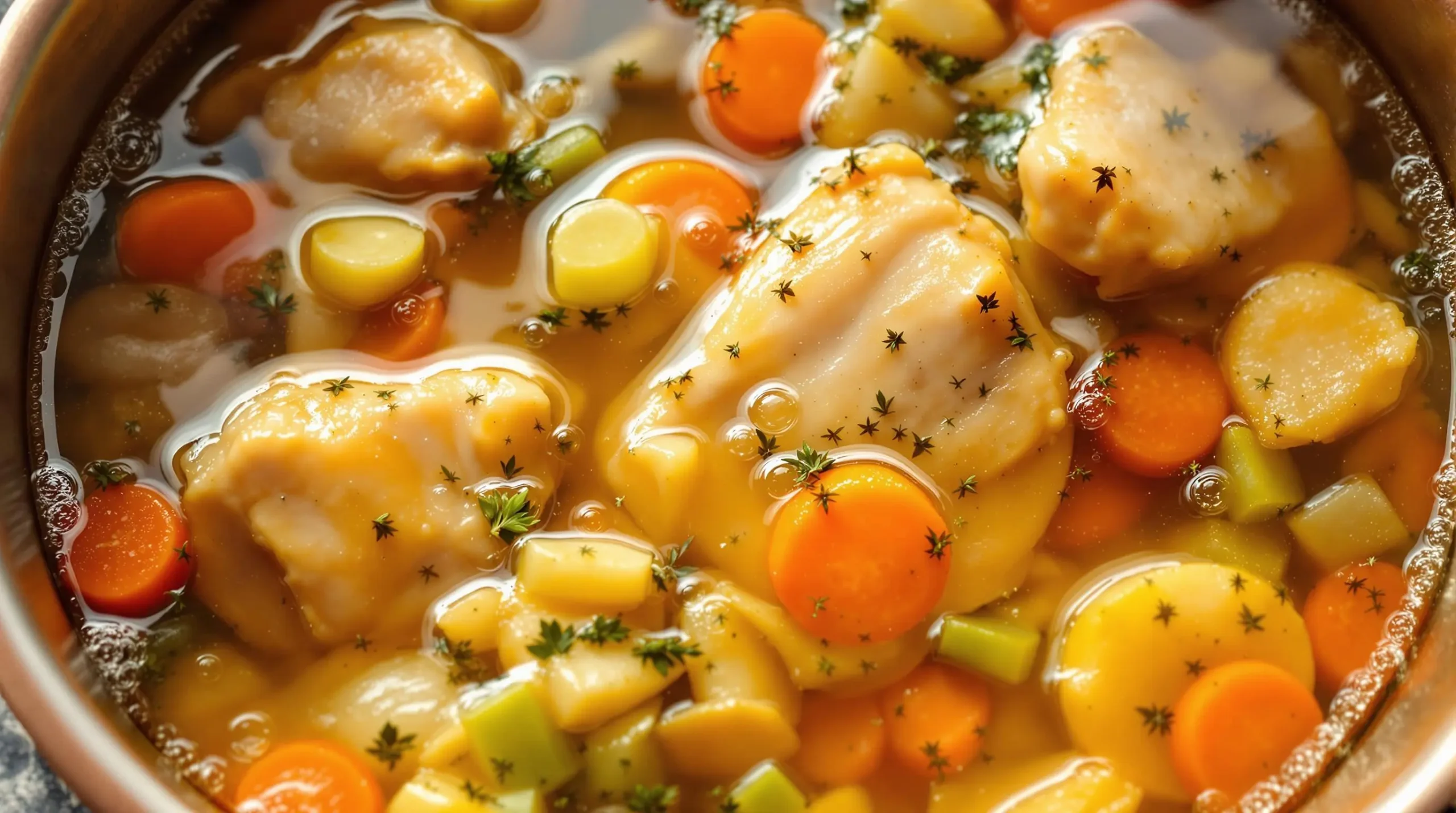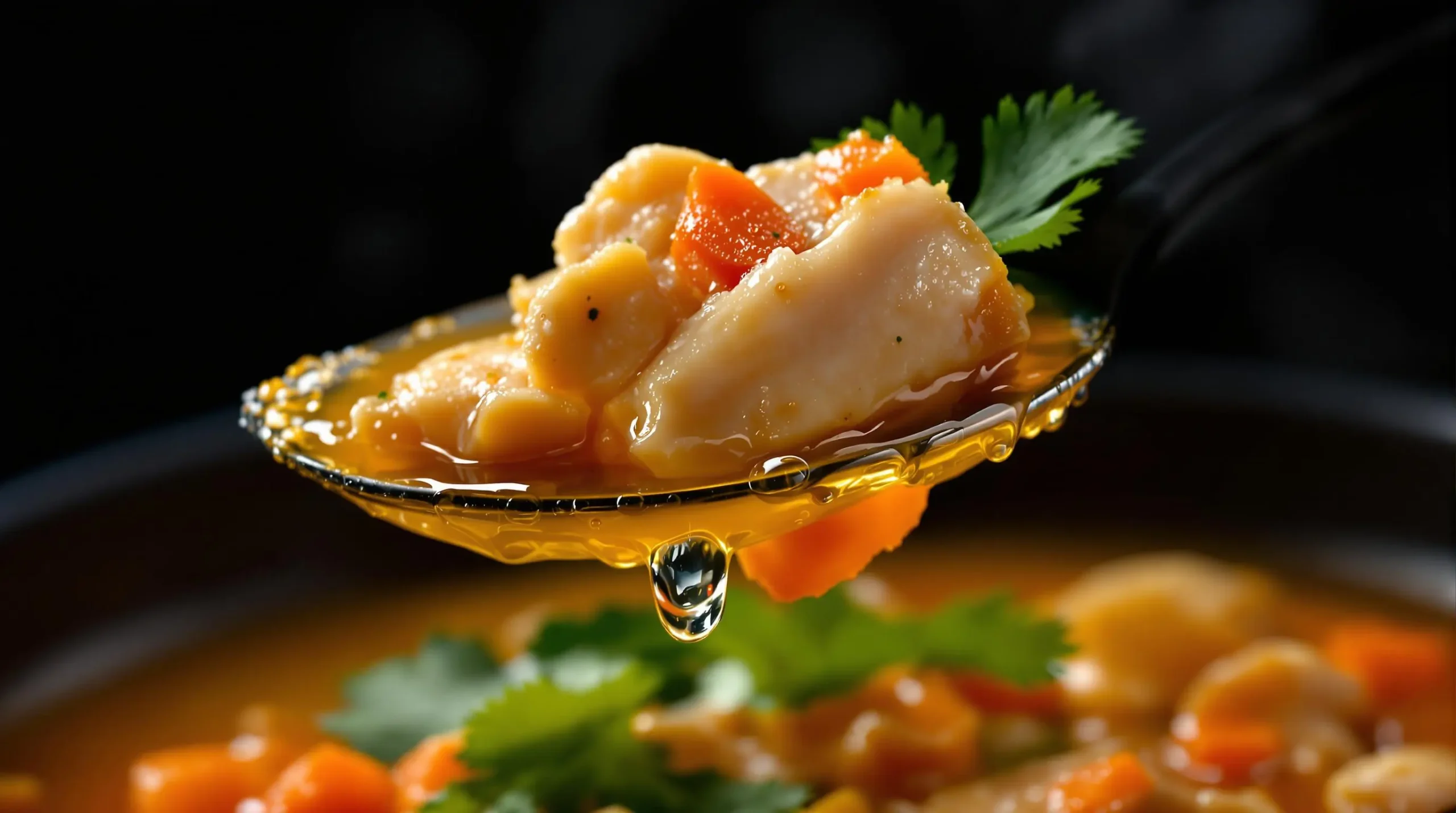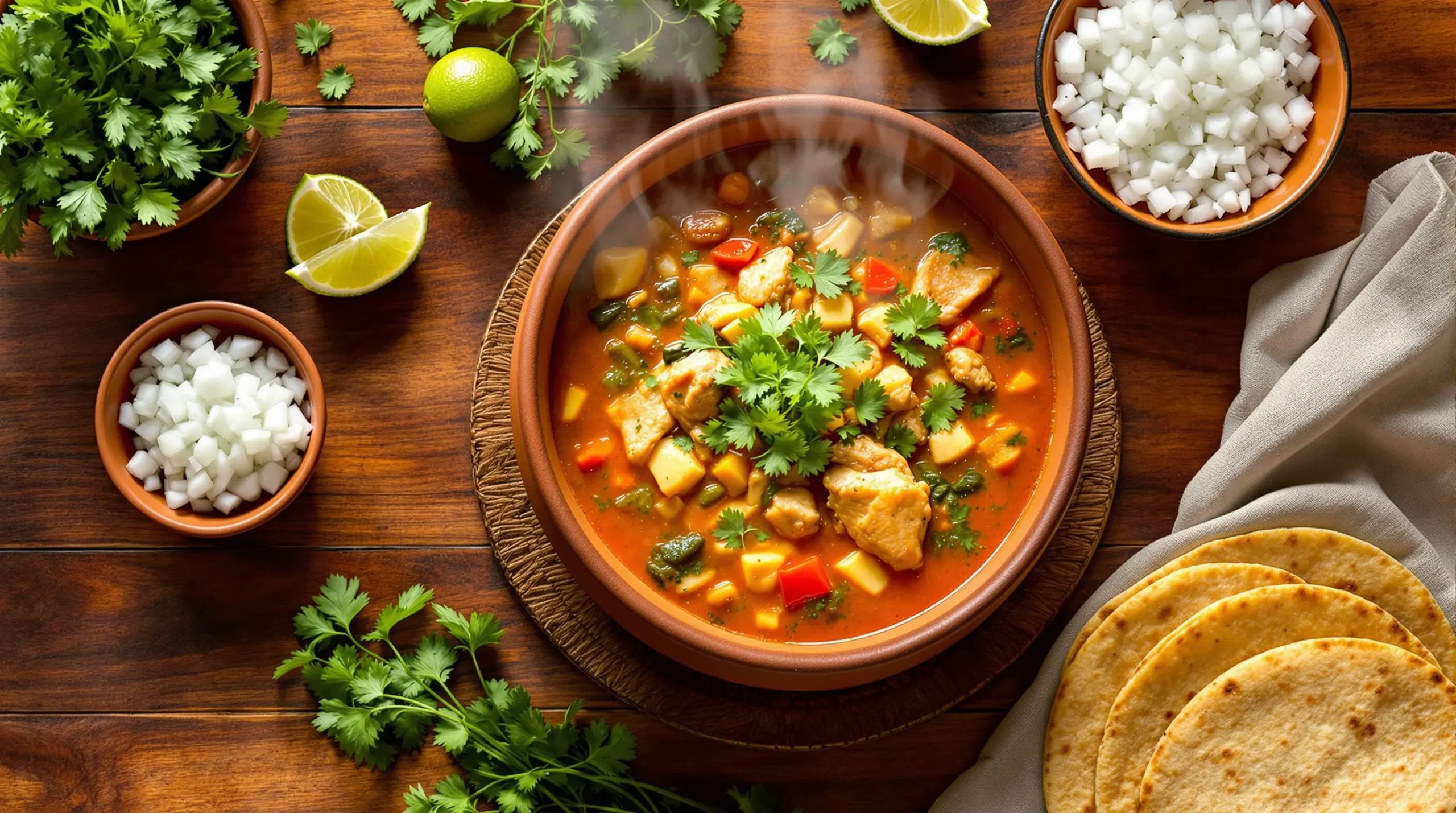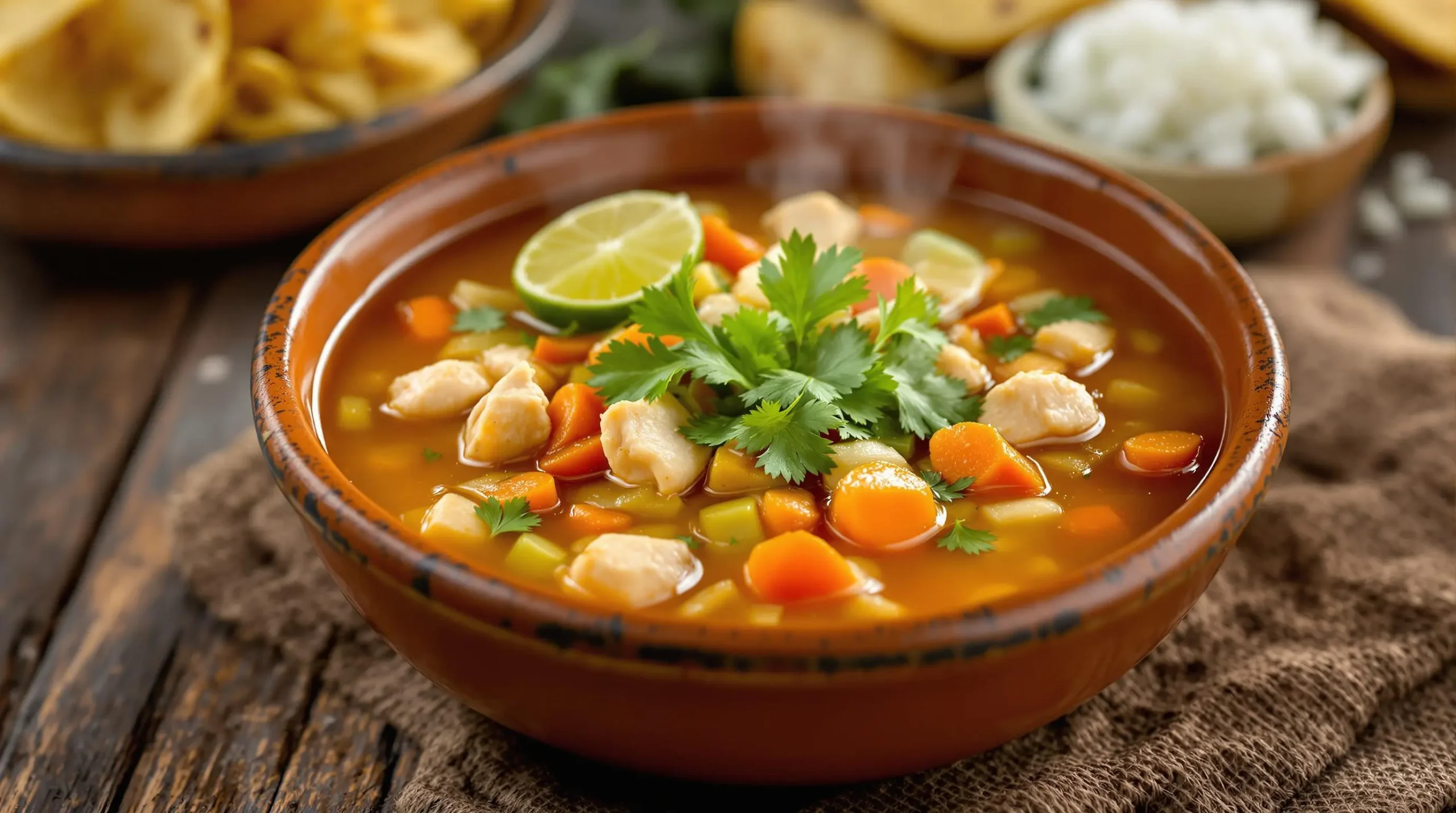Traditional Mexican Chicken Soup Made Simple
There’s nothing quite like a steaming bowl of homemade sopa de pollo on a chilly day. This cherished Mexican chicken soup recipe wraps you in warmth like a cozy blanket, bringing comfort with every spoonful. From the tender chunks of chicken to the perfectly cooked vegetables, each element plays its part in creating this beloved comfort food.
As a staple in Mexican households for generations, this sopa de pollo recipe carries the essence of traditional home cooking. The aromatic blend of fresh cilantro, Mexican oregano, and lime creates an inviting fragrance that fills your kitchen. Moreover, the combination of fresh vegetables and carefully seasoned broth makes this soup a satisfying meal any time of year.
What sets this authentic recipe apart is its straightforward preparation and adaptability. Whether you prefer your soup with rice or noodles, the basic technique remains the same. Additionally, you can adjust the seasonings to match your taste preferences while maintaining the classic flavors that make this dish special.
In the following sections, we’ll explore the essential ingredients and step-by-step instructions for creating this timeless soup. From selecting the right cuts of chicken to achieving the perfect broth consistency, you’ll learn all the techniques needed to master this traditional recipe. Let’s begin with gathering our ingredients and preparing for this culinary journey.
Now, let’s dive into what you’ll need to create this comforting bowl of goodness.
Understanding Sopa de Pollo Recipe
What is Sopa de Pollo?
Sopa de pollo holds a treasured place in Mexican cuisine, serving as both a daily staple and a celebratory dish. This traditional chicken soup recipe combines tender pieces of chicken with fresh vegetables in a flavorful broth, creating a dish that’s both simple and satisfying. Throughout Mexico’s diverse regions, families have passed down their unique versions of sopa de pollo recipe through generations.
While the basic elements remain consistent, regional variations showcase local ingredients and preferences. For instance, coastal areas often include seafood additions, while inland regions might incorporate more root vegetables. Additionally, some regions prefer rice as the standard grain, while others traditionally use thin noodles or fideos.
The traditional ingredients for an authentic sopa de pollo typically include:
- Fresh whole chicken or chicken pieces
- Aromatic vegetables (onions, garlic, celery)
- Fresh cilantro and Mexican oregano
- Seasonal vegetables (carrots, potatoes, chayote)
- Rice or thin noodles
- Mexican lime wedges for serving

Essential Components and Variations
The heart of any successful sopa de pollo lies in its carefully prepared ingredients. First and foremost, selecting quality chicken is crucial – many cooks prefer using whole chickens to create a richer broth. Furthermore, fresh vegetables contribute both flavor and texture to the final dish.
When it comes to ingredient substitutions, this recipe offers considerable flexibility:
- Chicken parts can replace whole chicken
- Regular oregano can substitute for Mexican oregano
- Various seasonal vegetables can be incorporated
- Different types of noodles or grains can be used
Quality considerations play a vital role in achieving the best results:
- Choose fresh, never-frozen chicken when possible
- Select firm, bright-colored vegetables
- Use fresh herbs rather than dried when available
- Opt for homemade broth over store-bought alternatives
To maintain authenticity while adapting to modern kitchens, consider these key elements:
- Allow sufficient time for the broth to develop flavor
- Layer seasonings gradually throughout cooking
- Keep vegetables crisp-tender rather than overcooked
- Adjust salt levels gradually during cooking
The preparation method remains relatively consistent across variations, though cooking times may differ based on specific ingredients. Moreover, the soup’s versatility allows for personalization while maintaining its traditional essence. Whether served as a main course or starter, this comforting dish continues to bring families together around the table.
As we move forward, we’ll explore the specific techniques and steps needed to create your own perfect bowl of sopa de pollo. These detailed instructions will help ensure success in recreating this beloved Mexican classic in your own kitchen.
Recipe Instructions for Sopa de Pollo
Preparation Steps
Before diving into cooking your sopa de pollo recipe, proper preparation ensures a smooth cooking experience. First, gather all your ingredients and equipment to create an organized workspace. Additionally, having everything ready before you begin helps maintain the ideal cooking flow.
Essential equipment for this recipe includes:
- Large stockpot or Dutch oven (at least 6-quart capacity)
- Sharp knife and cutting board
- Large strainer or colander
- Measuring cups and spoons
- Large serving ladle
For ingredient preparation:
- Cut chicken into manageable pieces if using whole
- Dice onions, carrots, and celery uniformly
- Mince garlic finely
- Chop fresh cilantro and separate stems from leaves
- Wash and cut remaining vegetables into bite-sized pieces
Cooking Process
The success of your sopa de pollo recipe depends largely on following the proper cooking sequence. Begin by heating your pot over medium heat and adding a small amount of oil. Next, sear the chicken pieces until golden brown on all sides, working in batches if necessary.
Follow these essential steps:
- Add aromatics (onions, celery, garlic) to the pot
- Pour in water or stock to cover ingredients
- Bring to a gentle boil, then reduce to simmer
- Add harder vegetables first, followed by softer ones
- Incorporate rice or noodles at the appropriate time
Watch for these visual cues during cooking:
- Clear, not cloudy, broth
- Vegetables that maintain their shape while tender
- Chicken that easily pulls from the bone
- Rice or noodles cooked to the right texture
Tips and Techniques
To elevate your sopa de pollo recipe to the next level, consider these professional tips:
Enhance flavor by:
- Skimming foam from the surface regularly
- Adding herbs in stages for layered flavor
- Adjusting seasoning gradually throughout cooking
- Finishing with fresh lime juice and cilantro
Common mistakes to avoid:
- Overcrowding the pot when browning chicken
- Boiling instead of simmering
- Adding all vegetables at once
- Oversalting early in the cooking process
For the best results:
- Allow sufficient time for flavors to develop
- Keep the broth at a gentle simmer
- Test vegetable doneness frequently
- Adjust seasonings just before serving
Remember that patience plays a crucial role in developing the rich flavors characteristic of traditional Mexican cooking. Furthermore, maintaining consistent temperature throughout the cooking process ensures all ingredients cook evenly and retain their texture. Finally, taste and adjust seasonings frequently to achieve the perfect balance of flavors in your finished soup.
Serving and Variations of Sopa de Pollo Recipe
Serving Suggestions
The presentation of your sopa de pollo recipe plays a vital role in creating an authentic Mexican dining experience. First, serve the soup piping hot in deep bowls, allowing the aromatic steam to enhance the experience. Additionally, arrange traditional accompaniments on the table for guests to customize their bowls.
Traditional accompaniments include:
- Fresh lime wedges
- Diced white onion
- Chopped fresh cilantro
- Warm corn tortillas
- Mexican-style rice
- Dried chile flakes
For the most appealing presentation:
- Ladle clear broth and ingredients carefully
- Arrange larger pieces of chicken and vegetables attractively
- Place garnishes in small serving bowls
- Keep tortillas warm in a traditional cloth wrapper
Recipe Variations
The versatility of this sopa de pollo recipe allows for numerous adaptations while maintaining its comforting essence. Throughout Mexico’s diverse regions, families add their unique touches to this classic dish. Moreover, modern interpretations continue to evolve while respecting traditional flavors.
Popular regional variations include:
- Coastal versions with added seafood
- Northern style with extra vegetables
- Yucatan-inspired with lime and achiote
- Mexico City version with rice and chipotle
For modern adaptations, consider:
- Using quinoa instead of rice
- Adding seasonal vegetables
- Incorporating different herb combinations
- Experimenting with various chiles
Storage and Reheating
Proper storage ensures your soup maintains its flavor and quality for several days. First, allow the soup to cool completely before transferring it to airtight containers. Furthermore, storing broth and solid ingredients separately helps preserve the texture of vegetables and prevents them from becoming mushy.
Storage guidelines:
- Refrigerate for up to 4 days
- Keep broth and solids separate when possible
- Store garnishes separately
- Label containers with dates
For reheating:
- Warm broth gently over medium heat
- Add solid ingredients once broth is hot
- Heat until just simmering
- Adjust seasoning if needed
Freezing instructions:
- Use freezer-safe containers
- Leave headspace for expansion
- Freeze for up to 3 months
- Thaw overnight in refrigerator

When reheating frozen soup, warm it slowly to maintain the texture of the ingredients. Additionally, you might need to add fresh herbs or a squeeze of lime to brighten the flavors. Finally, always check the temperature before serving to ensure it’s heated thoroughly.
For best results when storing and reheating, remember that fresh garnishes make a significant difference in the final presentation. Furthermore, keeping the broth at a gentle simmer during reheating helps preserve the delicate flavors of this beloved Mexican dish. With proper storage and reheating techniques, you can enjoy this comforting soup for several days after preparing it.
Making the perfect sopa de pollo can raise many questions, especially when aiming for authentic Mexican flavors. Here are the most common questions about this beloved chicken soup recipe, along with detailed answers to help you create the perfect bowl every time.
Frequently Asked Questions About Sopa de Pollo Recipe
Is caldo de pollo good for protein?
Indeed, any sopa de pollo recipe provides an excellent source of protein, with each serving containing approximately 20-25 grams, mainly from the tender chicken pieces. The combination of lean chicken meat and hearty vegetables creates a well-balanced meal that’s both satisfying and nourishing.
What is the meaning of caldo de pollo?
Caldo de pollo directly translates to ‘chicken broth’ or ‘chicken soup’ in Spanish. This traditional Mexican soup features whole chicken pieces, fresh vegetables, and aromatic herbs. The basic sopa de pollo recipe typically includes carrots, celery, onions, and various seasonings that create its distinctive flavor profile.
Why is caldo de pollo good when sick?
When feeling under the weather, caldo de pollo offers several comforting benefits. The warm broth provides necessary hydration while helping to clear nasal congestion. Additionally, the combination of ingredients in this traditional soup helps soothe sore throats. The vegetables and chicken together create a nourishing meal that’s easy to digest when you’re not feeling your best.
Where did la sopa de pollo con arroz originate?
The origins of sopa de pollo con arroz can be traced to both Spanish and Mexican culinary traditions, although variations of this beloved dish can be found throughout Latin America. The soup evolved from traditional European chicken soups, as various regions incorporated their local ingredients and distinctive spices. Over time, each culture added its own twist to the basic recipe, resulting in numerous delicious variations.
Conclusion: Mastering Your Sopa de Pollo Recipe
As we’ve explored this traditional sopa de pollo recipe together, you’ve learned the essential techniques and tips for creating this beloved Mexican soup at home. The beauty of this dish lies in its adaptability while maintaining its comforting essence. Whether you choose to follow the classic preparation or experiment with regional variations, the fundamentals remain consistent – quality ingredients, patient cooking, and careful seasoning.
Remember these key points for success:
- Start with fresh, high-quality ingredients
- Take time to develop the broth’s flavor
- Add vegetables in stages for perfect texture
- Season gradually throughout cooking
- Serve with traditional garnishes
Additionally, don’t hesitate to make this recipe your own. While respecting the traditional foundations, feel free to incorporate seasonal vegetables or adjust seasonings to your family’s taste preferences. Furthermore, the make-ahead nature of this soup makes it perfect for busy households, as the flavors often improve overnight.
For the best results, keep these final tips in mind:
- Taste and adjust seasonings before serving
- Store components separately when possible
- Reheat gently to maintain ingredient texture
- Add fresh garnishes just before serving
Most importantly, cooking sopa de pollo is about more than following a recipe – it’s about creating moments of warmth and comfort for your family and friends. As you become more comfortable with the basic technique, you’ll develop an intuition for the perfect balance of flavors and textures that make this dish special.

We encourage you to start your own tradition with this timeless recipe. Moreover, don’t forget to share your experiences and variations with others, as this is how cherished family recipes evolve and persist through generations. Happy cooking!

